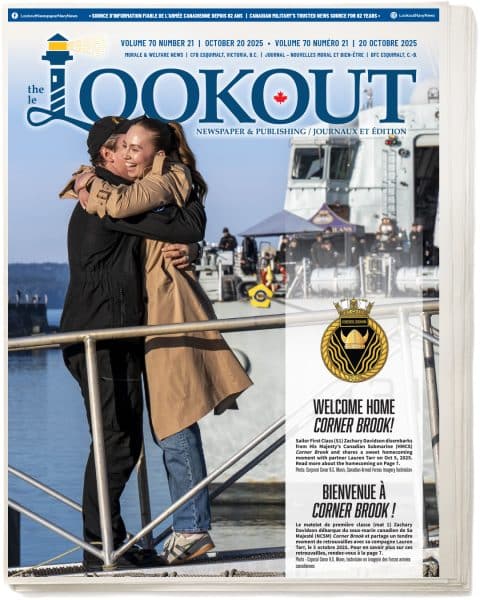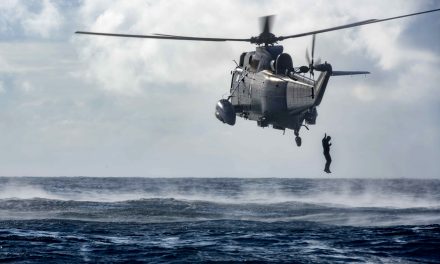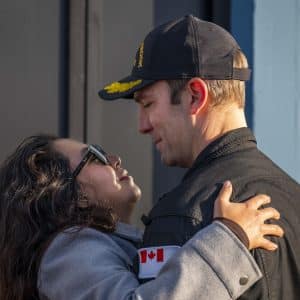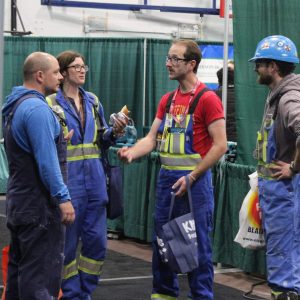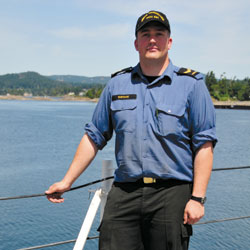
LS Tom Eustace
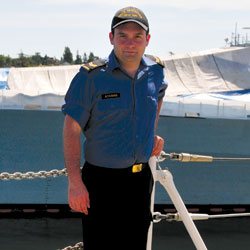
LS Firat Ataman
For eight hours a day, seven days a week, a team of rotating military members guards the Tomb of the Unknown Soldier in Ottawa, Ontario, as part of the National Sentry Program from April 9 to Nov. 10.
Rain or shine, these members stand guard over the tomb of an unidentified Canadian soldier from the First World War who represents all who sacrificed their lives for the peace and freedom of Canadians.
Leading Seaman Firat Ataman and Leading Seaman Tom Eustace, both sailors from HMCS Vancouver, were two of seven CFB Esquimalt members chosen to guard the tomb in early May.
“I applied out of pure honour and pride,” says LS Eustace. “I was just hoping I’d be able to get it.”
LS Eustace, named after a family member who died in service during the First World War, says he applied to continue upholding the honour of his military family.
LS Ataman, who moved to Canada from Turkey 13 years ago, says he wanted to wear his military uniform in Canada’s capital city.
After both made it through a competitive application and interview process, they were approved to attend in late March. From there, the sailors set about preparing for sentry duty.
“I started off by doing research on the tomb itself, so that I would have a stronger appreciation for what I was about to do,” says LS Ataman.
Apart from learning the history of the tomb, the sailors had their uniforms freshly tailored, and got duplicates should they need a change of uniform.
The large kit list filled four suitcases with boots, slacks, formal shirts, and even their gabardines.
The biggest preparation challenge was honing their sentry duty skills.
“We practiced drills constantly up at the Naden drill shed with navy members who guarded last year,” says AB Eustace.
“I think we were both a little nervous about the drills, because that’s not something the navy practices routinely.”
From the moment they arrived at the 33 Brigade Headquarters in Ottawa on May 26, the 18 navy members from across Canada, including AB Eustace and LS Ataman, started drill practice non-stop for seven days.
“There were lots of tired nights,” says LS Ataman.
“But it was worth it because we were completely prepared to perform at the ceremony and during our guard rotations.”
Apart from participating in the Battle of the Atlantic festivities, naval members were present as observers for a “Victory in Europe” wreath-laying ceremony at the National War Memorial.
But both sailors agree the culminating event was guarding the tomb.
“The first day I was nervous,” says LS Ataman.
“I was just thinking about my drill and my uniform, and worrying about not making a mistake.
There are lots of eyes watching you: tourists, military members.
But after that, you start paying attention to the people visiting the tomb.”
LS Ataman says his appreciation for guarding only continued to increase as he relaxed into his role, and began to observe the visitors.
“There are people who come by themselves, or with their families, or in large school groups. There is everyone from currently serving members to veterans, to Afghanistan war survivors. Some of them kneel to pray, some laid out flowers. I ended up feeling what they were feeling,” he says.
“I felt their loss.”
Both sailors stood guard for one hour, twice a day.
They were paired with another navy member and positioned at ease at diagonal corners of the tomb.
The two were not allowed to communicate with the public or move in any way, with the exception of the occasional, perfectly synchronized march.
In order to communicate with their partner guard to initiate a march, guards used sound signals, like tapping their rifles on the ground, or hand motions.
“There were days when it would be 36 degrees, or sideways rain, and it would actually be quite difficult to stand there without moving,” says LS Eustace.
“But you’d look down and see the tomb, and be just fine after that.”
The tomb holds a marble sarcophagus, roughly six by four feet.
Originally located in a graveyard in Vimy Ridge, France, the body was unearthed and repatriated back to Canada in May 2000, where it now rests before the National War Memorial in Confederation Square.
“The site doesn’t just honour that one buried person,” says LS Ataman.
“But the thousands of people that have lost their lives in the Boer War, Korean War, World War One and Two, and Afghanistan.”
Because many families of the fallen cannot travel to the original sites their loved ones are buried, the tomb is a place where they can pay their respects without travelling to Europe or the Middle East, or to any number of battle sites across the world.
“There’s thousands dead just from World War One alone that have no known resting place,” says LS Eustace.
“And how many ships have sunk in the Atlantic whose shipwreck sites are not possible to travel to?”
“It represents a lot of lives lost and a lot of broken hearts,” adds LS Ataman.
“We are so proud to be a part of that.”
Rachel Lallouz
Staff Writer
